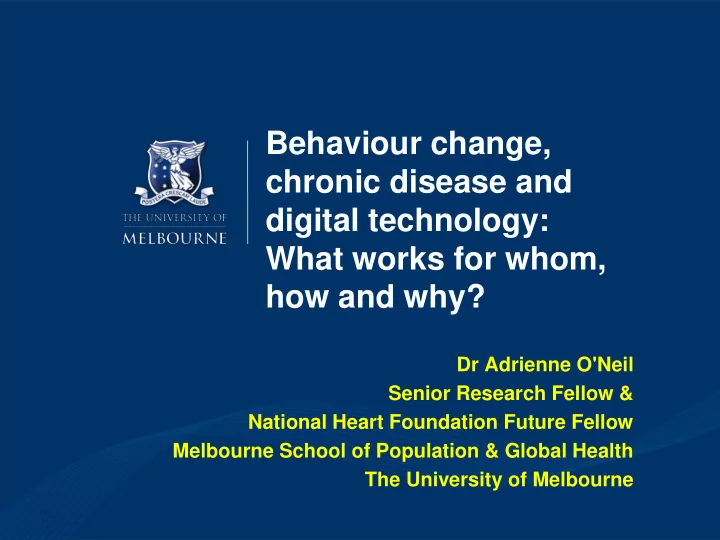

Behaviour change, chronic disease and digital technology: What works for whom, how and why? Dr Adrienne O'Neil Senior Research Fellow & National Heart Foundation Future Fellow Melbourne School of Population & Global Health The University of Melbourne
Not an isolated incident…. • Prospective cohort study post heart attack • Baseline • 12 month • 24 month interviews • 416 participants • Recruited from Monash Heart • 327 male (79%), 89 (21%) female • 43% Employed full time at time of cardiac event • Average age at baseline was 59 years
Variation in care coordination & quality “ I wish there was greater communication between the GP and the cardiologist ” (PT004) “ I saw my GP every week and the GP and cardiologist were communicating very well ” (PT008) “ At one hospital I had great follow-up but at another hospital I had no follow-up, no info, not the same staff quality and they didn ’ t explain outcomes properly ” (PT041) “ I ’ d like more frequent visits with the cardiologists. Currently it is only every 6 months ” (PT048) “ [I wanted] better coordination between doctors – each had different opinions on what medication to take and it was confusing ” (PT186)
Variation in access & length of CR “ I was not offered CR It was a glitch in the care. The cardiologist and GP had to follow-up with additional support ” (PT226) “ I was offered cardiac rehab but it was during work hours and very inflexible so I didn ’ t attend ” “ I had the option to continue rehab but I didn ’ t think it was needed ” (PT045) “ I still go to the gym where I did cardiac rehab [2 years later] ” “ I wish I had the option to complete cardiac rehab for longer, I had good momentum going to the gym and then it just stopped and there was no option to continue on longer ” (PT236) “ I would have liked longer cardiac rehab ” (PT142) “ Rehab could ’ ve been more informative and longer. Constant checking in is needed ” (PT111)
Requests for MH support “ I wish I had access to the HARP scheme earlier. The psychologist is brilliant. Having individual appointments without family is important ” (PT144) “ Cardiac rehab needed to include help on dealing with how other people in your life deal with heart attack ” (PT236) “ They could have introduced mindfulness into patients care and [information on] improving general health and wellbeing ” (PT106) “ More male perspective in cardiac rehab – there were only female staff ” (PT169) “ More info on return to work and mental health ” (PT062)
Requests for follow-up “ I wanted more follow-up care ” (PT224) “ I don ’ t feel I was supported very well. I would have liked someone to check on me by just calling ” (PT011) “ Very limited support for anything, did not receive any support whatsoever, would ’ ve like to have someone come by and check up on me like a nurse/doctor (wife was only person to rely on) ” (PT140) “ I wanted more time with a dietician/physio specialist ” “ [It would have been helpful] to implement health checks every 3 months to make sure everyone is on track ” (PT127)
Why is management of ACS so poor in Australia? • Treated as an acute, not chronic condition • Buy in from cardiologist about rehabilitation • Patients who fall through the cracks - Mental health issues - Access, time, motivation barriers
Phone delivered CR: MoodCare
Results: Efficacy Adjusting for baseline depression, at 6 months the intervention group demonstrated statistically significant improvements in: PHQ9 (but not CDS depression) Effect Size (ES): -0.3.
Results: Feasibility Satisfaction: 85% Good program compliance - median number of sessions=8 Acceptability: - Low study attrition (12%) - Reasonably high acceptability (68%) Convenience: - 77% of participants stated that travel was a barrier to attending face-to-face counselling sessions - 92% stated that using the telephone for counselling was convenient.
HOWEVER… • Not cost effectiveness! • No capacity to integrate into health system • Willingness of clinicians?
“Silicon Valley”
Why digital health?
What is the evidence? Meta review: 33 systematic reviews (15 meta-analyses) • Significant reductions in HbA1c over 1 yr for: – Web-based programs -0.49% [95% CIs:-0.70,-0.29] – mHealth programs -0.50% [95% CIs:-0.73,-0.27] – social media interventions -0.46% [95% CIs:-0.58,-0.34] • Interactive web + telephone for quitting smoking - RR: 2.05, 95% CIs:1.42,2.97 • mHealth interventions produced favourable: - weight ( Cohen’s d=0.43 ) - physical activity outcomes ( Hodge’s g=0.54 ) O’Neil et al (2016) JAMIA
Recommendation 1: Interactivity!
Recommendation 2: Uptake!
Recommendation 3: Use & engagement Usability Engagement Outcomes Acknowledgement: Shaira Baptista
How do we measure health behaviour change owing to technology use? Emotions Behaviours Biological • Dietary intake Complications Health Cognitions • Medication adherence • Markers Cardiovascular • Knowledge outcomes • Physical activity • Peripherovascular • • Understanding LDL-C • Mood management resulting in • Cerebrovascular • • Attitudes HDL-C • Metabolic syndrome • Psychological • • Self-efficacy TC, TG readmission • Smoking cessation ------------------------- • • Alcohol intake Recurrent ACS • Blood Pressure • Stroke • Kidney Function • Diabetes • Inflammation • Depression Social Support • Anxiety ---------------------------- • Poor Quality of Life • Death
How do we measure the population impact of digital health? • eCONSORT guidelines: (1) program development; (2) program access; (3) description of intervention(s) (model, theory, content, communications channels, prompts); (4) indication of where resources supplemented interventions; (5) data collection and storage process (security, usage); (6) attrition at various stages (usage, dose, engagement); (7) demographics on digital health divide; and (8) process outcomes O’Neil et al (2016) JAMIA
Major Issue for “digital public health” Acknowledgment: Prof Lis Nuebeck U Sydney
THANK YOU! Dr. Adrienne O’Neil Senior Research Fellow Melbourne School of Population & Global Health The University of Melbourne Victoria, AUSTRALIA adrienne.oneil@unimelb.edu.au @DrAdrienneOneil
Recommend
More recommend